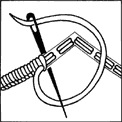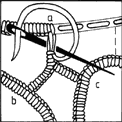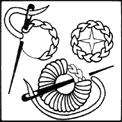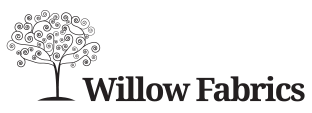|
In the past white work was the term used for all needlework consisting of white thread worked on white fabric, regardless of the technique used.

Buttonhole stitch edge

Richelieu bars

Eyelet embroidery

Needlework Ideas 3225/901 Kingston
|
Today one usually means the cutwork and eyelet embroideries such as Richelieu used to decorate Grandmother's trousseau.
Fabric type:
Closely woven, pure linen fabrics in plain weave are ideal. However, closely woven cottons used for bed linens are also suitable. Try tracing or grease-proof paper to trace a design, transfer it and work it. A monogram on a handkerchief or serviette/napkin is a good starting point to see if this is an embroidery technique that you can master and enjoy. The fabric must be densely woven so that the embroidery around the cut-out areas will hold. It must also be smooth so that you can easily draw (Water-erasable pencils & Transfer pencils) or iron on the pattern outlines. Clean, exact buttonhole stitch edges and outlines are only possible on fine-weave fabrics.
Recommended fabrics:
We recommend 3225 KINGSTON pure linen with 55 threads/inch. It fulfills all the demands made by this time-consuming embroidery, is closely woven, smooth and has a high thread count. 3218 BATIST in 100% cotton is also suitable for very delicate, fragile white work.
Embroidery thread:
4-ply embroidery yarn is generally used, the weight depending upon the fabric type and the stitches employed. We recommend 4-ply yarn #20 or #25 on 3225 KINGSTON . For white work, always use a sharply pointed embroidery needle that accommodates your yarn.
|





